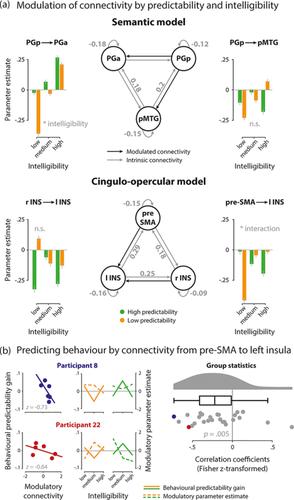当前位置:
X-MOL 学术
›
Hum. Brain Mapp.
›
论文详情
Our official English website, www.x-mol.net, welcomes your
feedback! (Note: you will need to create a separate account there.)
Neural modelling of the semantic predictability gain under challenging listening conditions.
Human Brain Mapping ( IF 3.5 ) Pub Date : 2020-09-22 , DOI: 10.1002/hbm.25208 Anna Uta Rysop 1 , Lea-Maria Schmitt 2, 3 , Jonas Obleser 2, 3 , Gesa Hartwigsen 1
Human Brain Mapping ( IF 3.5 ) Pub Date : 2020-09-22 , DOI: 10.1002/hbm.25208 Anna Uta Rysop 1 , Lea-Maria Schmitt 2, 3 , Jonas Obleser 2, 3 , Gesa Hartwigsen 1
Affiliation

|
When speech intelligibility is reduced, listeners exploit constraints posed by semantic context to facilitate comprehension. The left angular gyrus (AG) has been argued to drive this semantic predictability gain. Taking a network perspective, we ask how the connectivity within language‐specific and domain‐general networks flexibly adapts to the predictability and intelligibility of speech. During continuous functional magnetic resonance imaging (fMRI), participants repeated sentences, which varied in semantic predictability of the final word and in acoustic intelligibility. At the neural level, highly predictable sentences led to stronger activation of left‐hemispheric semantic regions including subregions of the AG (PGa, PGp) and posterior middle temporal gyrus when speech became more intelligible. The behavioural predictability gain of single participants mapped onto the same regions but was complemented by increased activity in frontal and medial regions. Effective connectivity from PGa to PGp increased for more intelligible sentences. In contrast, inhibitory influence from pre‐supplementary motor area to left insula was strongest when predictability and intelligibility of sentences were either lowest or highest. This interactive effect was negatively correlated with the behavioural predictability gain. Together, these results suggest that successful comprehension in noisy listening conditions relies on an interplay of semantic regions and concurrent inhibition of cognitive control regions when semantic cues are available.
中文翻译:

具有挑战性的聆听条件下语义可预测性增益的神经建模。
当语音清晰度降低时,听众会利用语义上下文带来的约束来促进理解。左角回 (AG) 被认为可以推动这种语义可预测性增益。从网络的角度来看,我们询问特定语言和领域通用网络中的连接如何灵活地适应语音的可预测性和可理解性。在连续功能磁共振成像 (fMRI) 期间,参与者重复句子,这在最终单词的语义可预测性和声学可理解性方面有所不同。在神经层面,高度可预测的句子导致左半球语义区域(包括 AG 子区域(PGa,PGp)和后中颞回)的更强激活,当语音变得更易理解时。单个参与者的行为可预测性增益映射到相同的区域,但由额叶和内侧区域的活动增加补充。从 PGa 到 PGp 的有效连接增加了更易懂的句子。相反,当句子的可预测性和可理解性最低或最高时,从补充前运动区到左脑岛的抑制作用最强。这种交互作用与行为可预测性增益呈负相关。总之,这些结果表明,在嘈杂的听力条件下成功的理解依赖于语义区域的相互作用和当语义线索可用时对认知控制区域的同时抑制。从 PGa 到 PGp 的有效连接增加了更易懂的句子。相反,当句子的可预测性和可理解性最低或最高时,从补充前运动区到左脑岛的抑制作用最强。这种交互作用与行为可预测性增益呈负相关。总之,这些结果表明,在嘈杂的听力条件下成功的理解依赖于语义区域的相互作用和当语义线索可用时对认知控制区域的同时抑制。从 PGa 到 PGp 的有效连接增加了更易懂的句子。相反,当句子的可预测性和可理解性最低或最高时,从补充前运动区到左脑岛的抑制作用最强。这种交互作用与行为可预测性增益呈负相关。总之,这些结果表明,在嘈杂的听力条件下成功的理解依赖于语义区域的相互作用和当语义线索可用时对认知控制区域的同时抑制。这种交互作用与行为可预测性增益呈负相关。总之,这些结果表明,在嘈杂的听力条件下成功的理解依赖于语义区域的相互作用和当语义线索可用时对认知控制区域的同时抑制。这种交互作用与行为可预测性增益呈负相关。总之,这些结果表明,在嘈杂的听力条件下成功的理解依赖于语义区域的相互作用和当语义线索可用时对认知控制区域的同时抑制。
更新日期:2020-09-22
中文翻译:

具有挑战性的聆听条件下语义可预测性增益的神经建模。
当语音清晰度降低时,听众会利用语义上下文带来的约束来促进理解。左角回 (AG) 被认为可以推动这种语义可预测性增益。从网络的角度来看,我们询问特定语言和领域通用网络中的连接如何灵活地适应语音的可预测性和可理解性。在连续功能磁共振成像 (fMRI) 期间,参与者重复句子,这在最终单词的语义可预测性和声学可理解性方面有所不同。在神经层面,高度可预测的句子导致左半球语义区域(包括 AG 子区域(PGa,PGp)和后中颞回)的更强激活,当语音变得更易理解时。单个参与者的行为可预测性增益映射到相同的区域,但由额叶和内侧区域的活动增加补充。从 PGa 到 PGp 的有效连接增加了更易懂的句子。相反,当句子的可预测性和可理解性最低或最高时,从补充前运动区到左脑岛的抑制作用最强。这种交互作用与行为可预测性增益呈负相关。总之,这些结果表明,在嘈杂的听力条件下成功的理解依赖于语义区域的相互作用和当语义线索可用时对认知控制区域的同时抑制。从 PGa 到 PGp 的有效连接增加了更易懂的句子。相反,当句子的可预测性和可理解性最低或最高时,从补充前运动区到左脑岛的抑制作用最强。这种交互作用与行为可预测性增益呈负相关。总之,这些结果表明,在嘈杂的听力条件下成功的理解依赖于语义区域的相互作用和当语义线索可用时对认知控制区域的同时抑制。从 PGa 到 PGp 的有效连接增加了更易懂的句子。相反,当句子的可预测性和可理解性最低或最高时,从补充前运动区到左脑岛的抑制作用最强。这种交互作用与行为可预测性增益呈负相关。总之,这些结果表明,在嘈杂的听力条件下成功的理解依赖于语义区域的相互作用和当语义线索可用时对认知控制区域的同时抑制。这种交互作用与行为可预测性增益呈负相关。总之,这些结果表明,在嘈杂的听力条件下成功的理解依赖于语义区域的相互作用和当语义线索可用时对认知控制区域的同时抑制。这种交互作用与行为可预测性增益呈负相关。总之,这些结果表明,在嘈杂的听力条件下成功的理解依赖于语义区域的相互作用和当语义线索可用时对认知控制区域的同时抑制。











































 京公网安备 11010802027423号
京公网安备 11010802027423号